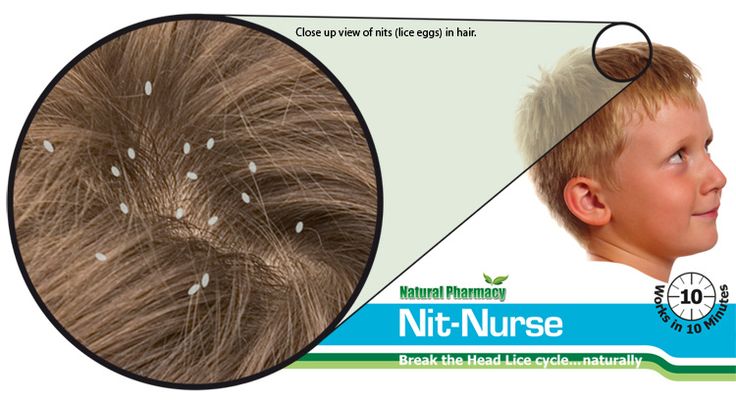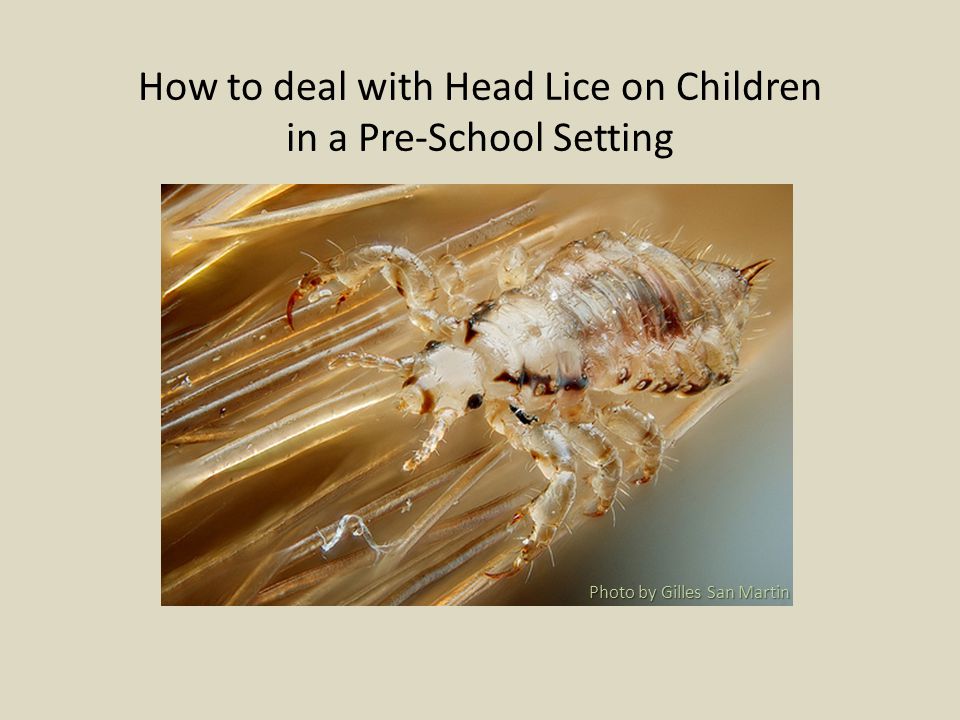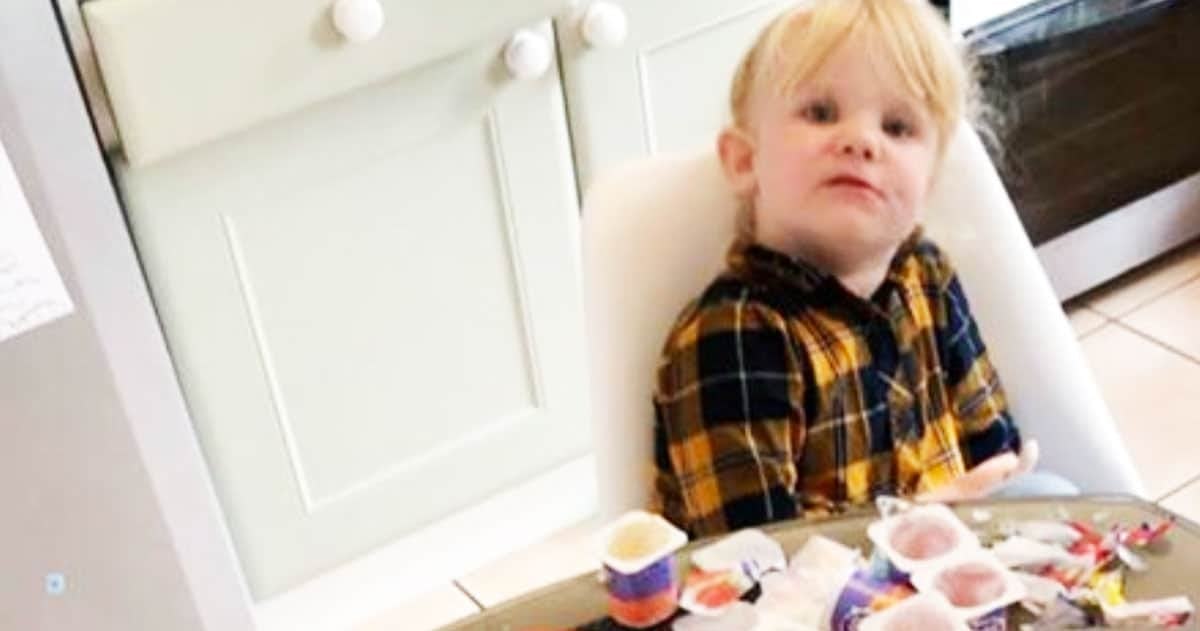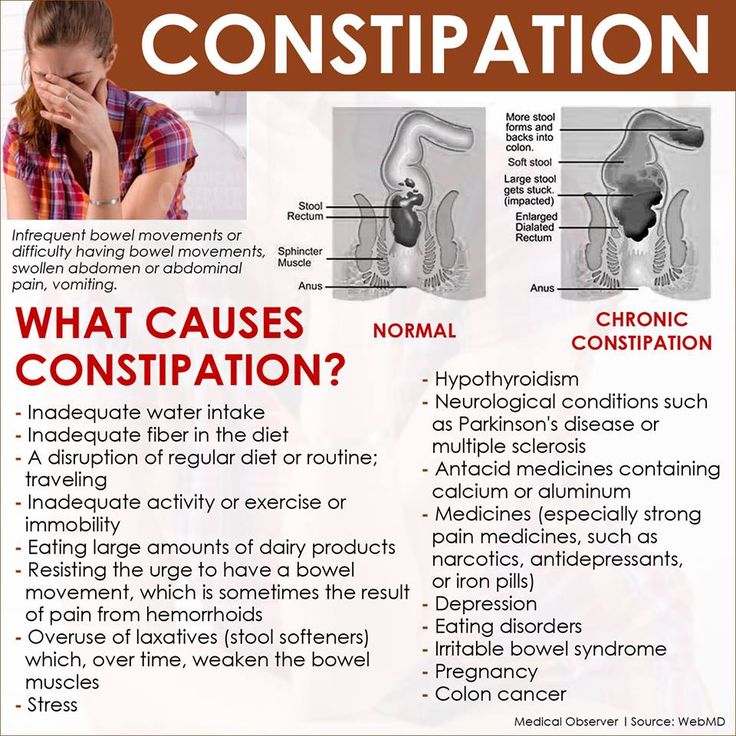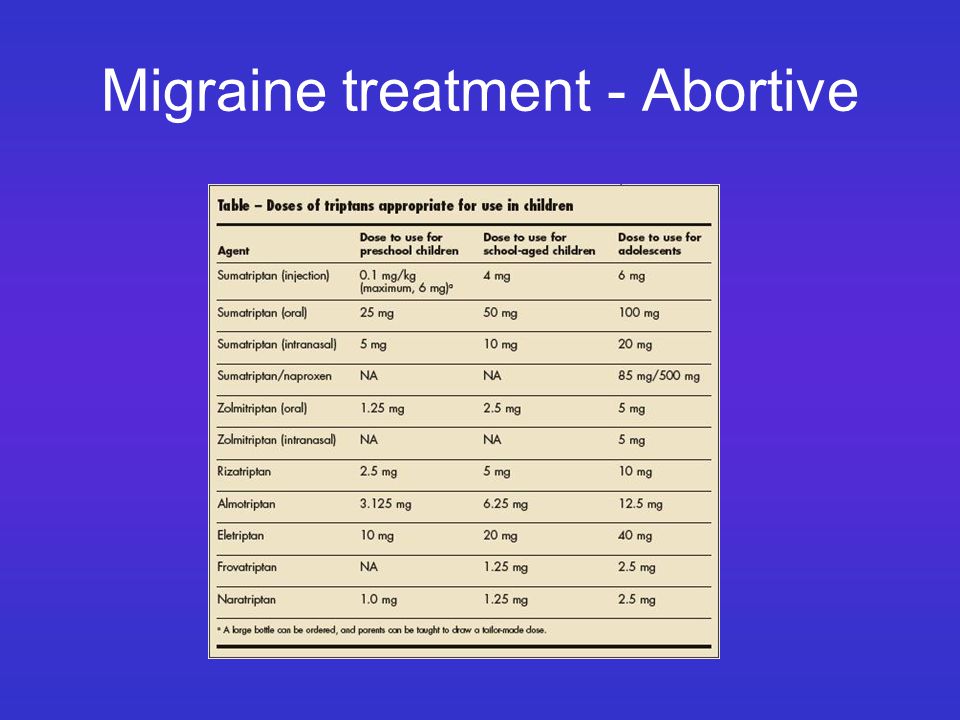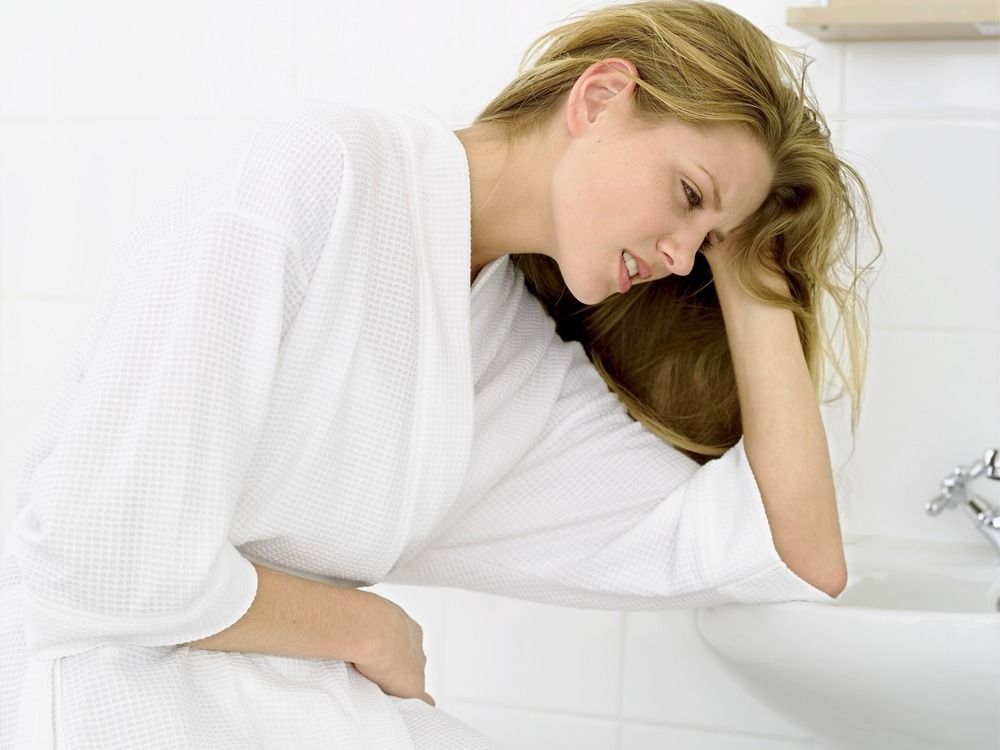How to check for lice on child
Head Lice: What Parents Need to Know
By: Dawn Nolt, MD, MPH, FAAP
Head lice are a common problem, especially among school-aged children and their families. The lice can attach to the hair of anyone's head. It doesn't matter if the hair is clean or dirty. Head lice are also found worldwide in all different places, such as in homes or schools or the country or city. It doesn't matter how clean, dirty, rich or poor the place or person is.
Though head lice may be a nuisance, they don't cause serious illness or carry any diseases. Head lice can be treated at home, but it's important to check with the doctor first. (See "Head Lice Medicines," below).
Read on for information to help you check for, treat and prevent the spread of head lice.
What are head lice?
Head lice are tiny bugs about the size of a sesame seed (2–3 mm long [mm stands for millimeter]). Their bodies are usually pale and gray, but their color may vary. One of these tiny bugs is called a louse.
Head lice feed on small amounts of blood from the scalp. They can't survive more than 1 day without a blood meal.
What are nits?
Lice lay and attach their eggs to hair close to the scalp. The eggs and their shell casings are called nits. Lice eggs are oval and about the size of a knot in thread (0.8 mm long and 0.3 mm wide) and usually yellow to white.
Some nits may blend in with some people's hair color, making them hard to see, and are often confused for dandruff or hair spray droplets. Nits attach to the hair with a sticky substance that holds them firmly in place. After the eggs hatch, the empty nits stay on the hair shaft.
What is the life cycle of head lice?
Head lice live about 28 days. They develop in 3 phases: egg (also called a nit), nymph, and adult louse.
Egg or nit. Eggs or nits hatch in 7 to 12 days, depending on the surrounding temperature.
 Eggs are usually found within 4 to 6 mm of the scalp and do not survive if they are farther away.
Eggs are usually found within 4 to 6 mm of the scalp and do not survive if they are farther away.Nymph. The nymph looks like an adult head louse but is much smaller (about the size of a pinhead [1.5 mm]). Nymphs become adults about 9-12 days after hatching.
Adult louse. An adult female louse can lay up to 10 eggs a day. It takes only about 12 to 14 days for newly hatched eggs to reach adulthood.
This cycle can repeat every 3 weeks if head lice are left untreated.
How common are head lice?
Head lice are most common in preschool- and elementary school–aged children. Each year millions of school-aged children in the United States get head lice. However, anyone can get head lice. Head lice are found worldwide.
How do head lice spread?
Head lice are crawling insects. They cannot jump, hop, or fly. The main way that head lice spread is from close, prolonged head-to-head contact. There is a very small chance that head lice will spread by sharing items such as combs, brushes, hats and sports helmets.
There is a very small chance that head lice will spread by sharing items such as combs, brushes, hats and sports helmets.
What are symptoms of head lice?
Itching on the areas where head lice are present is the most common symptom. However, it may take up to 4 to 6 weeks after lice get on the scalp before the scalp becomes sensitive to the lice saliva and begins to itch. Most of the itching happens behind the ears or at the back of the neck. Also, itching caused by head lice can last for weeks, even after the lice are gone.
How do you check for head lice?
Regular checks for head lice are a good way to spot head lice before they have time to multiply and infest (are present in large numbers) your child's head.
Seat your child in a brightly lit room.
Part their hair.
Look for crawling lice and for nits on your child's scalp a section at a time.
Live lice are hard to find. They avoid light and move quickly.

Nits will look like small white or yellow-brown specks and be firmly attached to the hair near the scalp. The easiest place to find them is at the hairline at the back of the neck or behind the ears. Nits can be confused with many other things such as dandruff, dirt particles or hair spray droplets. The way to tell the difference is that nits are firmly attached to hair, while dandruff, dirt or other particles are not.
Use a fine-tooth comb (such as a louse or nit comb) to help you search the scalp section by section.
What is the comb-out method for lice?
The comb-out method can be used to help check for nits and head lice or to help remove nits and head lice after head lice treatment. However, the comb-out method usually doesn't work on its own to get rid of head lice.
Here is how you use the comb-out method:
Step 1: Wet your child's hair.
Step 2: Use a fine-tooth comb (louse or nit comb) and comb through your child's hair in small sections.

Step 3: After each comb-through, wipe the comb on a wet paper towel. Examine the scalp, comb, and paper towel carefully.
Step 4: Repeat steps 2 and 3 until you've combed through all of your child's hair.
How do you treat head lice?
Check with your child's doctor before beginning any head lice treatment. The most effective way to treat head lice is with head lice medicine. After each treatment, using the comb-out method every 2 to 3 days for 2 to 3 weeks may help remove the nits and eggs.
Head lice medicine should be used only when it is certain that your child has living head lice. Remember, check with your child's doctor before starting any head lice medicine. Also, when head lice medicines are used, it is important to use them safely as directed.
Here are some safety guidelines for lice treatments:
Follow the directions on the package exactly as written.

Never let children apply the medicine. Medicine should be applied by an adult.
Always rinse the medicine off over a sink and not during a shower or bath, so the medicine doesn't run off the head onto other areas of skin. Place your child's head over a sink and rinse the medicine off with warm water (not hot water).
Never place a plastic bag on a child's head.
Do not leave a child alone with medicine in his or her hair.
Store medicine in a locked cabinet, out of sight and reach of children.
Check with your child's doctor before beginning a second or third medicine. Your child may just need to repeat the same medication, or switch to a new one.
Ask your child's doctor if you have any questions or if treatments you have tried have not gotten rid of lice.

Warning about dangerous home remedies for lice
Never use dangerous products like gasoline or kerosene or medicines made for use on animals! Also, do not use home remedies, such as petroleum jelly, mayonnaise, tub margarine, essential oils or olive oil, because no studies prove they work.
What head lice medicines are available?
Check with your child's doctor before beginning any treatment. See chart, below, for a list of head lice medicines approved by the U.S. Food and Drug Administration.
Head Lice Medicines | |
Permethrin lotion (1%) Brand name products: Nix, Elimite and Acticin |
|
Pyrethrin-based product (shampoo or hair mousse) Brand name products: RID, A-200, Pronto, R&C, Triple X and Licide |
|
|
Ivermectin lotion (0.5%)
Brand name product: Sklice |
|
Malathion lotion (0.5%) |
|
Spinosad topical suspension (0.9%) |
|
Ivermectin 3-mg tablets |
|
What else do I need to know about treating head lice?
You may want to wash your child's clothes, towels, hats, and bed linens in hot water and dry on high heat if they were used within 2 days before head lice were found and treated.
 You do not need to throw these items away. Items that cannot be washed may be sealed in a plastic bag for 2 weeks or dry-cleaned..
You do not need to throw these items away. Items that cannot be washed may be sealed in a plastic bag for 2 weeks or dry-cleaned..Do not spray pesticides in your home. They can expose your family to dangerous chemicals and are not needed when you treat your child's scalp and hair properly.
All household members and close contacts should be checked and treated for head lice if necessary.
About school "no-nit" policies
Some schools have "no-nit" policies stating that students who still have nits in their hair cannot return to school. The American Academy of Pediatrics and National Association of School Nurses discourage such policies and believe a child should not miss or be excluded from school because of head lice.
Remember
Head lice don't put your child at risk for any serious health problems. Products should be used only if those products are safe. If your child has head lice, work quickly but safely to treat your child to prevent the head lice from spreading.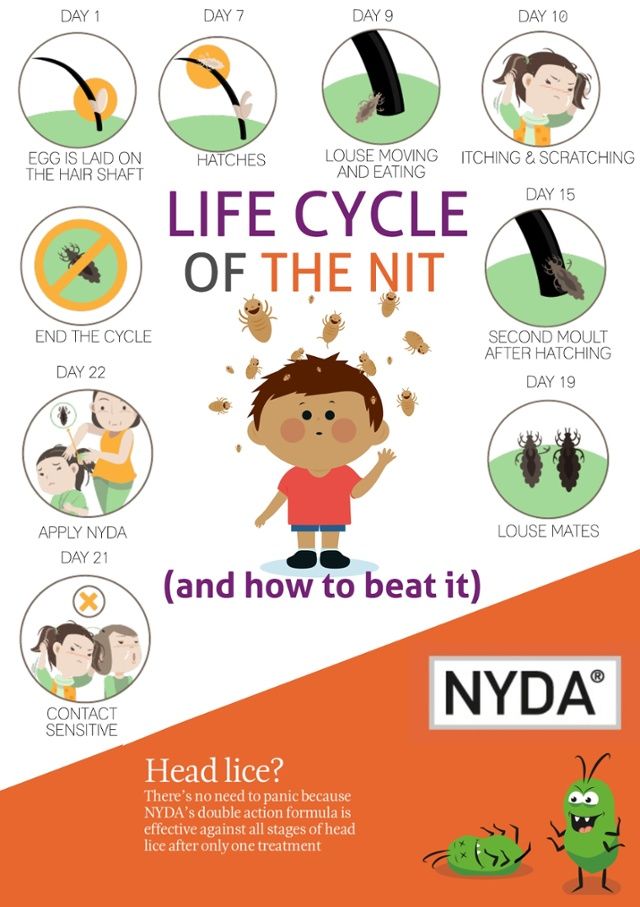
More information
-
Head Lice Treatment Myths & Realities
- Controlling Head Lice & Reducing Stigma
-
Lice-Head (KidsDoc Symptom Checker)
-
Head Lice (AAP Clinical Report)
-
Head Lice Prevention & Control (CDC)
-
Head Lice Management in Schools (National Association of School Nurses)
About Dr. Nolt
Dawn Nolt, MD, MPH, FAAP is a Professor of Pediatric Infectious Diseases at Oregon Health & Science University Doernbecher Children's Hospital in Portland. Dr. Nolt currently serves as medical director of the antimicrobial stewardship program and the department of infection prevention and control at the hospital. She is a member of the American Academy of Pediatrics, and previously served on its Committee on Infectious Diseases. Outside of the hospital, Dr. Nolt enjoys spending time with her husband and daughter, discussing the positive impact of superheroes, both in comic books and real life.
The information contained on this Web site should not be used as a substitute for the medical care and advice of your pediatrician. There may be variations in treatment that your pediatrician may recommend based on individual facts and circumstances.
Head Lice (for Parents) - Nemours KidsHealth
What Are Head Lice?
Head lice are tiny wingless insects. They live among human hairs and feed on blood from the scalp.
Head lice are a common problem, especially for kids. They spread easily from person to person, and sometimes are tough to get rid of. Their bites can make a child's scalp itchy and irritated, and scratching can lead to infection.
Head lice are annoying, but they're not dangerous and they don't spread disease. They're not a sign of poor hygiene — head lice need blood and they don't care whether it's from someone who's clean or dirty.
It's best to treat head lice right away to prevent them from spreading.
What Are the Signs & Symptoms of Head Lice?
Even though they're tiny, you can see head lice. Here's what to look for:
- Lice eggs (nits). These look like tiny yellow, tan, or brown dots before they hatch. Lice lay nits on hair shafts close to the scalp, where the temperature is perfect for keeping warm until they hatch. Nits look a bit like dandruff, but aren't removed by brushing or shaking them off.
Unless a child has many head lice, it's more common to see nits in the hair than live lice crawling on the scalp. Lice eggs hatch 1–2 weeks after they're laid. After hatching, the remaining shell looks white or clear and stays attached to the hair shaft. This is when it's easiest to spot them, as the hair is growing longer and the egg shell is moving away from the scalp.
- Adult lice and nymphs (baby lice). Adult lice are no bigger than a sesame seed and are grayish-white or tan. Nymphs are smaller and become adult lice about 1–2 weeks after they hatch.
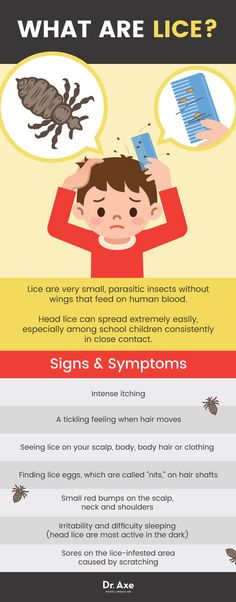 This life cycle repeats itself about every 3 weeks. Most lice feed on blood several times a day, and they can survive up to 2 days off the scalp.
This life cycle repeats itself about every 3 weeks. Most lice feed on blood several times a day, and they can survive up to 2 days off the scalp. - Scratching. With lice bites come itching and scratching. This is due to a reaction to the saliva (spit) of lice. But the itching doesn't always start right away. It depends on how sensitive a child's skin is to the lice. It might take weeks for kids with lice to start scratching. They may complain, though, of things tickling or moving around on their heads.
- Small red bumps or sores from scratching. Some kids have mild irritation from scratching, while others may get a bothersome rash. Scratching a lot can lead to a bacterial infection. Watch for swollen lymph nodes (glands) on the back or front of the neck, and red, tender skin that might have crusting and oozing. Doctors can treat a skin infection with an antibiotic.
How Can I Check My Child for Head Lice?
Look for lice and nits on the scalp, behind the ears, and around the nape of the neck. It's rare for lice to be in eyelashes or eyebrows.
It's rare for lice to be in eyelashes or eyebrows.
It can be tough to find a nymph or adult louse. Usually, there aren't many of them and they move fast. Look for nits attached to the hair near the scalp. They can look like dandruff or dirt. To tell them apart, pull on the little speck with your fingers — dandruff and dirt can be removed, but nits stay stuck. A magnifying glass and a bright light can help with your inspection.
The best way to check is by using a fine-tooth comb on wet hair. After applying lots of conditioner, comb the hair out in very small sections, and look for lice or nits on the comb. You can wipe the comb onto a tissue or paper towel where it will be easier to see them.
If your child is itchy and scratching their head but you're not sure if it's lice, ask your child's doctor or the nurse at school or childcare center to take a look.
How Are Head Lice Treated?
The two main ways to treat lice are:
- medicine
- removing by hand
Medicine: Medicated shampoos, cream rinses, and lotions are available that kill lice. These may be over-the-counter (OTC) or prescription medicines. If you buy OTC, be sure it's safe for your child's age. While some over-the-counter shampoos are safe for kids as young as 2 months, others are safe only for kids 2 years and older.
These may be over-the-counter (OTC) or prescription medicines. If you buy OTC, be sure it's safe for your child's age. While some over-the-counter shampoos are safe for kids as young as 2 months, others are safe only for kids 2 years and older.
In some areas, lice have developed resistance to some medicines. This means they no longer work to kill the lice. Ask your doctor or a pharmacist to recommend a medicine known to work in your area. The doctor also can prescribe a medicated shampoo or lotion. For very resistant lice, the doctor might recommend taking medicine by mouth.
Whether the medicine is OTC or prescription, always follow the directions closely. Applying too much can be harmful. Applying too little won't work.
Removing by hand: Removing lice and nits by hand can finish the job if the medicine did not completely rid your child of lice (no medicine is 100% effective). It is also an option for anyone who doesn't want to use an insecticide. And it is the only option for children 2 months old or younger, who should not use medicated lice treatment.
To do this, use a fine-tooth comb on wet, conditioned hair every 3–4 days for 3 weeks after the last live louse was seen. Wetting the hair temporarily stops the lice from moving, and the conditioner makes it easier to get a comb through the hair.
There's no need to buy electronic combs that claim to kill lice or make nits easier to remove. No studies have been done to back up these claims. You also don't need to buy special vinegar solutions to apply to the scalp before picking nits. Water and conditioner works fine.
Though petroleum jelly, mayonnaise, or olive oil are sometimes used to try to suffocate head lice, these treatments may not work. If medicine doesn't work and you want to try these methods, talk to your doctor first.
A few important things to NOT do: Don't use a hairdryer after applying scalp treatments. Some treatments for lice use flammable ingredients and can catch on fire. Don't use pesticide sprays or hire a pest control company to try to get rid of the lice; these can be harmful.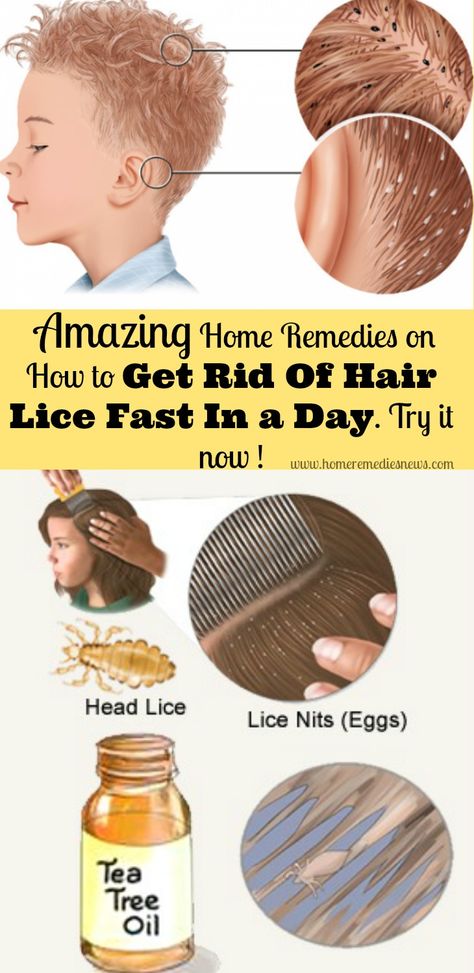 Don't use essential oils (such as ylang ylang oil or tea tree oil) to treat lice on the scalp. They can cause allergic skin reactions and aren't approved by the U.S. Food and Drug Administration (FDA). Don't ever use highly flammable chemicals such as gasoline or kerosene on anyone.
Don't use essential oils (such as ylang ylang oil or tea tree oil) to treat lice on the scalp. They can cause allergic skin reactions and aren't approved by the U.S. Food and Drug Administration (FDA). Don't ever use highly flammable chemicals such as gasoline or kerosene on anyone.
Are Head Lice Contagious?
Head lice spread quickly from person to person, especially in group settings like schools, childcare centers, slumber parties, sports activities, and camps.
They can't fly or jump, but they have claws that let them crawl and cling to hair. They spread through head-to-head contact, and sharing clothing, bed linens, combs, brushes, and hats.
Pets can't catch head lice and pass them on to people or the other way around.
Do Kids Have to Stay Home From School?
In the past, kids with head lice were kept home from school. But now doctors don't recommend these "no-nit" policies. In most cases, a child who has lice should stay at school until the end of the day, go home and get treatment, and return to school the next day. While they are at school, kids should avoid head-to-head contact with other kids. It can help to put long hair up in a bun, braid, or ponytail.
Can We Prevent Head Lice?
To get rid of head lice and their eggs, and to help prevent them from coming back:
- Wash all bed linens, stuffed animals, and clothing used during the 2 days before treatment (any lice that fell off before that will not be alive). Wash in very hot water (130°F [54.4°C]), then put them in the hot cycle of the dryer for at least 20 minutes.
- Dry clean items that can't be washed. Or put them in airtight bags for 2 weeks.
- Vacuum carpets and any upholstered furniture (in your home or car), and throw away the vacuum cleaner bag.
- Soak hair-care items like combs, barrettes, hair ties or bands, headbands, and brushes in hot water or throw them away. Tell kids not to share these items.
- Because lice easily pass from person to person in the same house, check all family members.
 Treat everyone who has lice so they won't pass it back and forth.
Treat everyone who has lice so they won't pass it back and forth. - Tell kids to try to avoid head-to-head contact at school (in gym, on the playground, or during sports) and while playing at home with other children.
- Every 3 or 4 days, check kids who had close contact with a person who has lice. Then, treat any who have lice or nits close to the scalp.
Will They Ever Be Gone?
As many parents know, fighting head lice can be an ongoing battle. There's no doubt that they can be hard bugs to get rid of.
If you've tried everything and your child still has lice, it could be because:
- some nits were left behind (if you see nits far from the scalp — more than ½ inch (1 cm) — and no live lice, these are probably dead and treatment likely isn't needed)
- your child is still around someone who has lice
- the treatment you're using isn't effective
If your child has lice 2 weeks after you started treatment or if your child's scalp looks infected, call your doctor.
There are professional lice treatment centers that remove lice and nits for a fee. These services are effective but often costly.
Looking Ahead
Remind your child that while having lice can be embarrassing, anyone can get them. Having head lice is not a sign of dirtiness or poor hygiene. The pesky little bugs can be a problem no matter how often kids do — or don't — wash their hair or bathe.
Dealing with head lice can be frustrating, but be patient. Follow the treatments and prevention tips from your doctor, and soon your family will be lice-free.
How to understand that you have lice?
Recommendations
Pediculosis is a very unpleasant disease. People shudder at the mere thought that they can pick up lice somewhere. It is even more unpleasant to imagine that someone will notice insects on you before you yourself know about your illness. We tell you how to understand that lice are wound up and get rid of them very quickly. We will also tell you how to prevent pediculosis, because this is the best scenario. nine0003
We will also tell you how to prevent pediculosis, because this is the best scenario. nine0003
How to tell if you have lice - symptoms
There are people who only imagine something white in their hair, already begin to itch furiously and imagine that they have lice. This phenomenon even came up with a name: phthiriophobia, or pediculophobia.
Of course, it is not necessary to lead to phobias. But a certain amount of vigilance won't hurt either. After all, becoming a victim of parasites is not so difficult. You can catch them:
- on a bus or subway during rush hour; nine0015 at a concert or other public event;
- in a hotel, hostel, sanatorium, sleeping car - from insufficiently well processed bed linen;
- in the hospital - from roommates;
- from upholstered furniture where the infected person was sitting;
- in the pool - right on the water;
- in the open wardrobe of any institution or institution - from one coat to another.

Phthiriasis (pediculosis pubis) can be contracted through sexual contact. nine0003
But most often adults are infected with head lice by children. They themselves easily find "passengers" in pre-school and school educational institutions, children's health camps, just in close contact with each other during games and head-to-head activities.
Therefore, it is impossible to completely exclude the possibility of contracting head lice, and it is better to listen to your feelings, regularly examine yourself in the mirror.
Here's how to tell if a person has lice:
- Itching. Of course, if the head itches, it is not always associated with lice. But if the itching does not go away, but only intensifies, leads to scratching (wounds) - it definitely makes sense to ask someone to carefully examine your hair. If the fears are confirmed, lice, nits, bite marks will be found on the head. nine0016
- Lice. It is impossible to detect them on yourself - they are so small that you can hardly see them in the mirror.
 But with a careful examination of the head of another person, for example, a child, they can be seen. You need to look behind the ears, on the back of the head along the hairline. Parasites love these places where the skin is the most delicate and thin, it is easier to bite through. When there are still few insects, they are localized here.
But with a careful examination of the head of another person, for example, a child, they can be seen. You need to look behind the ears, on the back of the head along the hairline. Parasites love these places where the skin is the most delicate and thin, it is easier to bite through. When there are still few insects, they are localized here. - Nits. These are lice eggs. It is thanks to them that pediculosis is most often detected. The eggs are whitish and teardrop shaped. The female attaches them to the base of the hair with a reliable adhesive substance. If you notice white particles on your hair in the mirror, but doubt whether it is dandruff or nits, it is easy to dispel doubts. It is enough to run your hand over the hair: dandruff will fall off, nits will not. nine0016
- Bites. Traces of lice bites are hardly noticeable at first. Small reddish spots are difficult to see on the scalp. But they itch unbearably, so patients (especially children) comb them to an impressive wound size.
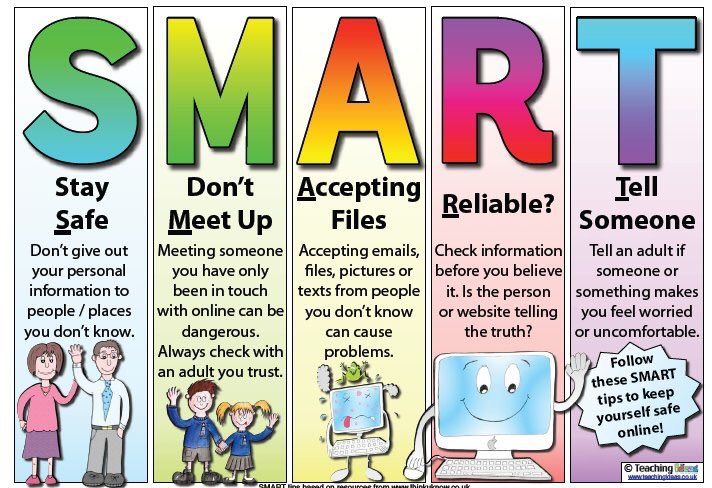
- Confusion, dryness, brittleness of hair. Parasites have a bad effect on the health of the hair, taking away their vitality. Does not improve the situation and the fact that the patient is constantly scratching his head. Sometimes it comes to signs of folliculitis: the hair begins to fall out, the bites darken and become like age spots, the skin becomes rough, becomes bumpy. nine0016
- Sleep disturbances, mood swings - this is another way to understand that a child has lice. Constant itching prevents you from sleeping properly. The patient becomes irritable, uncollected. Schoolchildren have impaired concentration, nervousness appears.
- Lice can also cause an allergic reaction. In this case, a rash, swelling and other allergic symptoms join the bite marks.
- With advanced pediculosis, patients sometimes comb their heads to purulent wounds, as a result of which the hair gets tangled into tangles that cannot be untangled - you can only cut it off. nine0016
Several of the last signs are characteristic of extremely advanced forms of pediculosis.
What to do if pediculosis is confirmed
If the fears about parasites are confirmed, the patient must be isolated from the team. You need to be treated at home: children do not attend school or kindergarten during this period, adults do not go to work. It is also better to minimize contacts with family members, since pediculosis is very contagious.
Of course, contrary to stereotypes, insects do not jump from head to head, but run fast. For some time they can be on bed linen, bedspreads, upholstered furniture, and from these items get into the hair of healthy people. nine0003
The class teacher at the school, the kindergarten teacher should be warned about the nature of the child's illness. There is nothing to be ashamed of: anyone can get infected. And employees of educational institutions need to strengthen preventive measures, carefully examine the heads of all children in a group, class. This will help prevent further spread of the disease.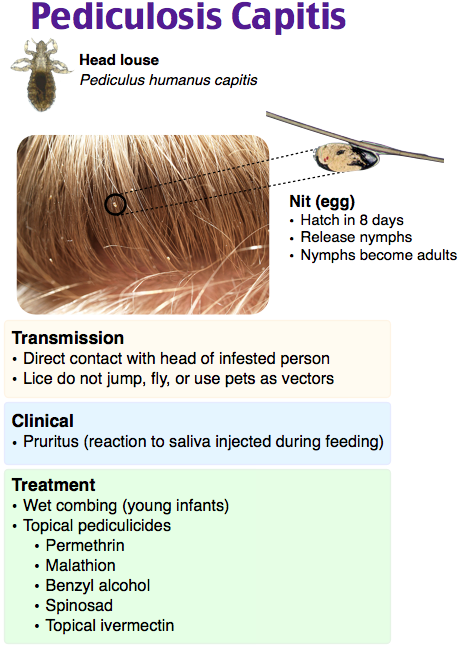
The patient's bed linen and underwear, hats should be boiled, outer clothing should be carefully examined and cleaned. Process combs, hairpins, soft toys. Things that cannot be boiled are sent to the freezer or hung outside in the winter in frosty weather. nine0003
And of course, you should immediately start treating pediculosis as soon as you have identified it in yourself or your child. Pediculicidal drugs are sold in pharmacies without a prescription. Some of them allow you to get rid of parasites in one application.
Effective remedy - Parasept
Parasept is a convenient and effective remedy for head lice, available as a spray or aerosol. The main active ingredient is dimethicone, a synthetic polymer that physically destroys parasites by blocking their spiracles. The composition does not contain toxins, therefore it is absolutely safe and recommended for use in children from 1 year old. nine0003
There is another group of drugs based on toxic effects - they affect the nervous system of lice. But over time, resistance develops to toxins, that is, the purchased drug may be ineffective. And insects cannot adapt to clogging of the respiratory organs. Therefore, Parasept is effective, regardless of the place and time of its acquisition and use.
But over time, resistance develops to toxins, that is, the purchased drug may be ineffective. And insects cannot adapt to clogging of the respiratory organs. Therefore, Parasept is effective, regardless of the place and time of its acquisition and use.
The product box contains everything you need to treat your hair: fine comb, hair band, gloves. The product must be applied to dry combed hair, without missing a single strand. And after half an hour it is already possible to comb out dead lice, larvae and nits with a comb. nine0003
Dimethicone is the same shampoo product that makes hair “smooth and silky”. So combing will be easy and painless. After the procedure, it is enough to wash your hair with regular shampoo.
In addition to dimethicone, the composition includes oils and plant extracts, which are natural antiseptics. They disinfect bite sites, relieve inflammation, and promote speedy healing. The composition smells good, does not flow.
Prevention
It is better not to get infected with parasites at all than to look for ways to get rid of them later. For this we recommend:
For this we recommend:
- avoid crowds, crowded places;
- when staying overnight in unfamiliar places (hotels, hostels, sleeping cars of trains, etc.), carefully inspect bed linen;
- in the pool carefully remove hair under a bathing cap;
- do not use other people's combs, hairpins, towels;
- to explain to children that you should not try on other people's hats or give them your own to try on;
- donate clothes to the cloakroom in plastic bags; nine0016
- take a shower regularly, change underwear and bed linen, teach children to observe hygiene standards;
- brush hair thoroughly every morning and evening, braid tight braids for girls to school or preschool;
- carry out "preventive examinations" of the head of children and other family members.
Now you know how to find out if you have lice and not miss the obvious or indirect signs of the disease. If you find pediculosis in a child, do not panic or figure out who is to blame.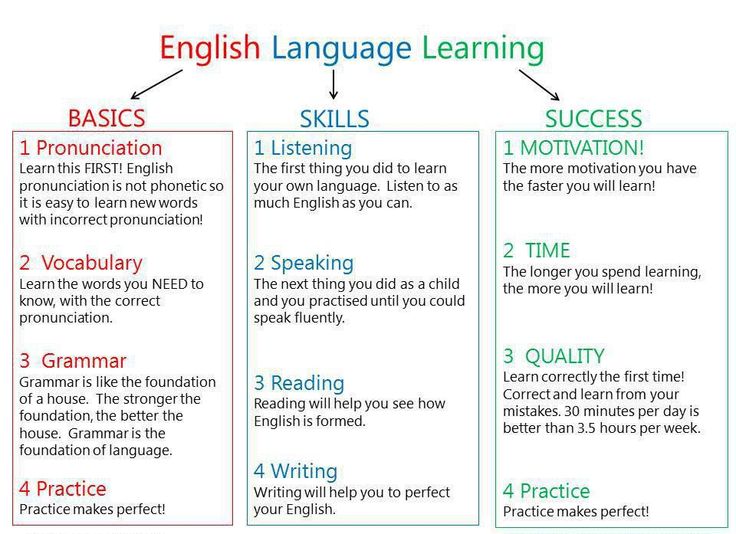 Just go to your nearest pharmacy for Parasept. And soon your baby will be completely healthy. For preventive purposes, it is recommended to repeat the treatment after two weeks. nine0003
Just go to your nearest pharmacy for Parasept. And soon your baby will be completely healthy. For preventive purposes, it is recommended to repeat the treatment after two weeks. nine0003
How to understand that you have lice, how to detect lice
Pediculosis is a very unpleasant disease. Everyone can pick up lice, regardless of their lifestyle and attitude to hygiene. Lice are easily transmitted from person to person, there are no special conditions for infection. You can get lice in any public place. This requires only the contact of a healthy person with an infected person. Many do not even suspect where and when they picked up parasites. And they do not always start the fight with them on time. Sometimes it takes quite a long time until a person finds himself with lice. During the incubation period of lice, they manage to breed and bring a lot of trouble. How to detect lice, what are the symptoms of pediculosis and how to deal with parasites, we will understand below. nine0003
Contents:
- Why and where do lice come from
- Early signs of head lice
- How to detect nits
- Mechanical Diagnosis and Treatment
Why and where do lice come from
Louse is a human parasite. The insect feeds on his blood and lives on his body. This applies to head and pubic lice. There is also a body louse that only feeds on a person, but lives in clothes, bedding or other textiles next to a person in order to always have access to food. nine0003
The insect feeds on his blood and lives on his body. This applies to head and pubic lice. There is also a body louse that only feeds on a person, but lives in clothes, bedding or other textiles next to a person in order to always have access to food. nine0003
Parasites are transmitted from person to person through contact or through the use of personal items. This insect cannot fly or jump, but crawls quickly. It can travel significant distances on any surface, so it is not necessary to touch the heads in order for the louse to move from the carrier to a new victim. Sometimes you can pick up a pest from the headrest in public transport or from a lounger in the sauna, where previous visitors left them. Lice can live outside the human body without problems for up to two days. They survive even in water, so you can pick them up anywhere. nine0003
The most risky places where you can get lice are places with a high concentration of people. Children bring lice from kindergartens, schools, summer camps, leisure complexes. Adults can become infected in a hospital, sanatorium, long-distance train, plane, prison, temporary residence center, barbershop, or swimming pool. If you visited an institution in which there were a lot of people at the same time, and they were there for a considerable time and could have close contact, then after visiting such a place you should be especially vigilant in order to detect lice in time and start treatment. nine0003
Adults can become infected in a hospital, sanatorium, long-distance train, plane, prison, temporary residence center, barbershop, or swimming pool. If you visited an institution in which there were a lot of people at the same time, and they were there for a considerable time and could have close contact, then after visiting such a place you should be especially vigilant in order to detect lice in time and start treatment. nine0003
Particular attention should be paid to children, especially in case of outbreaks of pediculosis in children's institutions. In kindergartens and schools, lice are common. Children easily pass them on to each other. At the same time, children usually cannot tell adults that they have parasites. They do not perceive itching as a symptom of the disease. In rare cases, in children, the head does not itch at all, even with a large accumulation of parasites. Therefore, parents should carefully examine children's heads when washing, combing, and simply upon returning from kindergarten or school. After visiting the children's camp, such an inspection is required. nine0003
After visiting the children's camp, such an inspection is required. nine0003
The first signs of head lice
When infested with lice, one or more individuals first appear on the head of a person. In such a quantity, they do not manifest themselves in any way. Single bites do not cause much discomfort. If one unfertilized female, nymph or male appeared on the head, then pediculosis will not develop, since the insect will simply live its life cycle without leaving offspring. But if males and females or at least one fertilized female appeared on the scalp, then immediately, along with the feeding process, the process of reproduction will begin. The head louse lays an average of 4 eggs per day. Within a few days, the number of parasites on the head will begin to increase exponentially. After 16 - 20 days from laying the nits, the louse becomes sexually mature. nine0003
Signs of lice:
- intolerable itching from bites that does not go away even after washing the head;
- sensation of moving hair;
- insects in hair, and their remains and excrement;
- nits are small (less than 1 mm) white, rounded eggs that attach to the hair at its base;
- scratches on the head, scratches, redness, papules, swelling at the bite sites;
- with a large number of lice and nits - tangled hair, tangles; nine0016
- human nervousness, restless sleep, decreased concentration.
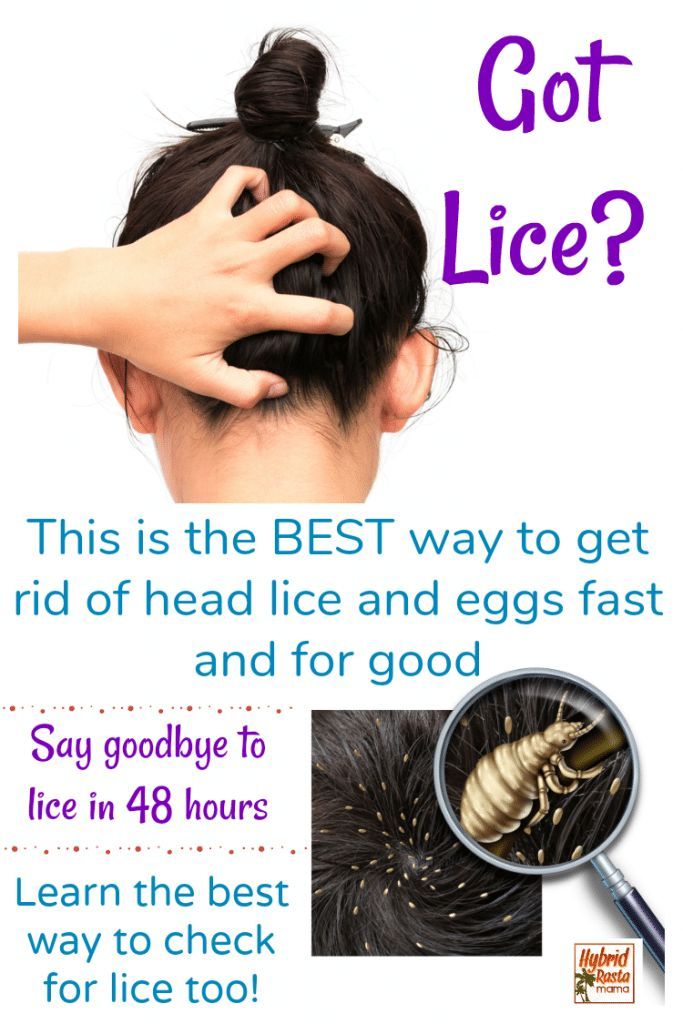
These signs are enough to diagnose head lice. To understand if there are lice, you just need to carefully examine the hair and scalp. Lice on the head is clearly visible with fair hair, especially in children. Adults with swarthy skin and dark hair will need to be examined more carefully.
Depending on the individual characteristics of the organism, lice bites cause allergic reactions up to fever and swollen lymph nodes. nine0003
Pediculosis is sometimes confused with scabies, dermatitis, eczema or psoriasis. In these diseases, only the condition of the skin after bites is common - irritated, swollen, reddened, with scratches and scratches, infected wounds. The main distinguishing feature of pediculosis is the presence of insects on the scalp and their eggs on the hairs. By the way, you can also find insects and traces of their vital activity on the personal belongings of the victim, on bed linen, towels, so they also need to be carefully examined to understand if a person has lice.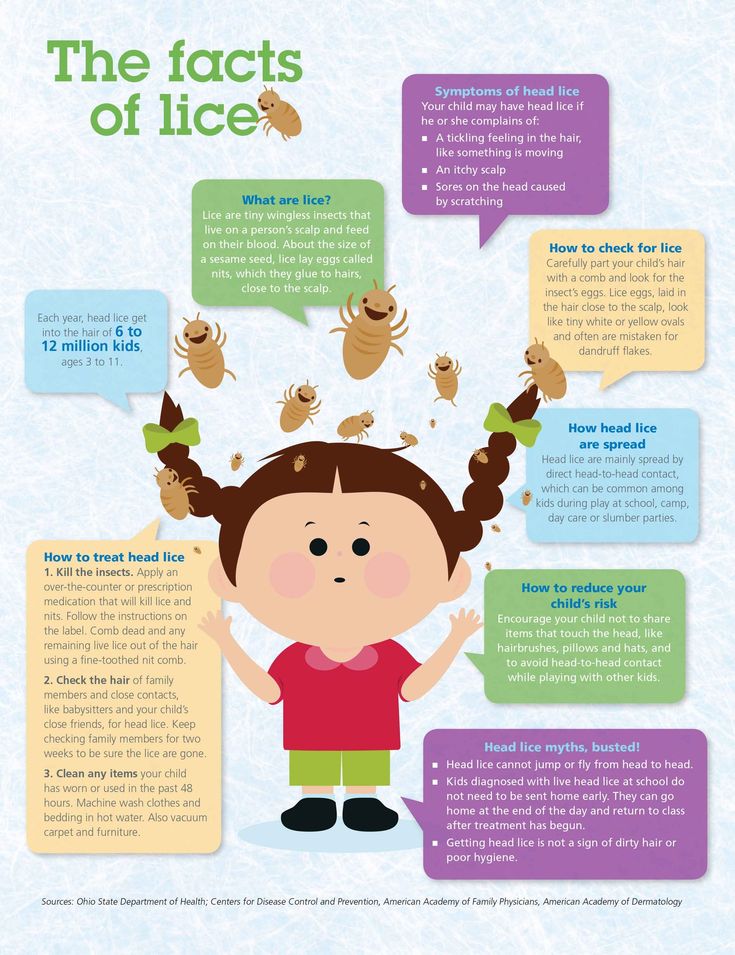 nine0003
nine0003
How to spot nits
Adults are not always visible without aids. They tenaciously hold on to the hair and can be motionless. These insects are brown or gray-brown in color, darken when saturated with blood. So sometimes they are indistinguishable against the background of hair.
If there are lice on the head, there must be nits - eggs of parasites. They are attached at the base of the hair, and only one nit can be fixed on one hair. But females lay their eggs crowded - on neighboring hairs. Therefore, with a strong infection, they are arranged in clusters. Nits are often confused with dandruff. They are as small and white as flaking scalp flakes. But the difference is that dandruff is located directly on the skin, and nits are located on the hair. nine0003
When examining the head, to determine if you have lice and nits, you need to pay attention to the hair in the back of the head and temples. It is there that a large number of nits are usually found. They sit firmly on the hair, as the female secretes a special secret that sticks them. When you try to remove the nits, you have to make an effort. In the treatment of pediculosis with folk remedies, vinegar rinse is used, which corrodes this sticky composition. If dandruff can be brushed off the head with a hand, then this does not work with nits. nine0003
They sit firmly on the hair, as the female secretes a special secret that sticks them. When you try to remove the nits, you have to make an effort. In the treatment of pediculosis with folk remedies, vinegar rinse is used, which corrodes this sticky composition. If dandruff can be brushed off the head with a hand, then this does not work with nits. nine0003
Mechanical method of diagnosis and treatment
The most important tool for detecting lice is a comb, or rather a comb with very densely spaced long teeth. They comb their hair to comb out lice and nits from them. This should be done subject to the following rules:
- it is better to comb out wet hair;
- it is desirable that not the person who picked up the lice comb out, but his assistant;
- cover the shoulders with a white towel so that the combed-out parasites fall on it; nine0016
- Combing is best done in a room that can then be treated with pediculicides, such as a bathroom.
